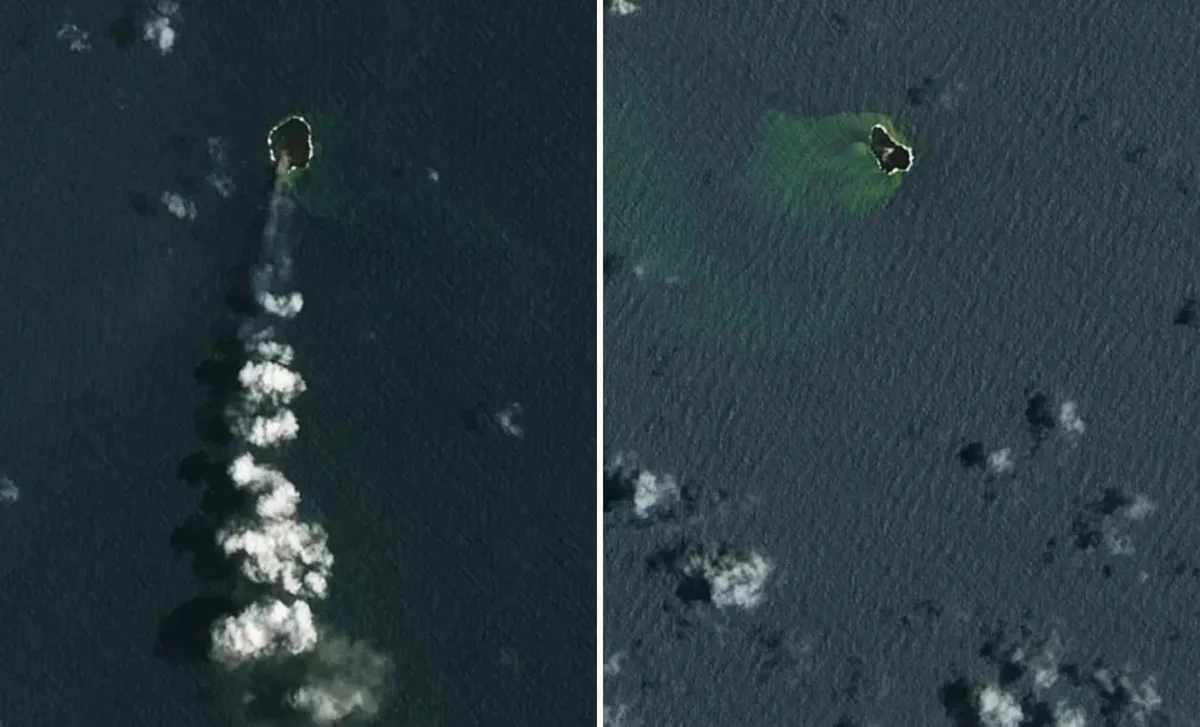
A dramatic transformation is taking place in the South Pacific, where a newly formed volcanic island is emerging from the ocean. Located in Tonga’s Home Reef, this growing landmass results from a series of underwater eruptions, steadily adding new terrain to the region. The island first surfaced in 2022, expanded further in 2023 and 2024, and has continued to grow into early 2025, drawing the attention of scientists eager to understand how long it will last.
Satellite imagery has captured the stunning evolution of this island, showcasing fresh lava flows cooling into solid rock. As the eruptions continue, the landscape remains in flux, offering researchers a rare opportunity to observe the birth of new land. While past volcanic islands in this area have often disappeared within months, this one is different—scientists believe it has a greater chance of survival due to the way it is forming.
According to SciTechDaily, the island has grown significantly since its initial formation. After breaking through the ocean’s surface in 2022, it has continued to expand through multiple eruptions, with major activity occurring in September 2023, January 2024, and June 2024. The most recent volcanic outbursts, recorded between December 2024 and January 2025, added another 3.7 hectares (9.1 acres) to its surface, bringing its total size to over 15 hectares (37 acres).
Satellite images taken by NASA’s Landsat 8 and 9 satellites reveal the island’s rapid transformation. Before-and-after comparisons show how new lava deposits have reshaped the coastline, extending the landmass further into the sea. Surrounding the island, discolored water provides additional clues about ongoing volcanic activity.
“Most likely, we’re seeing a large amount of yellow sulfur mixing with the blue ocean to give the plumes a greenish hue,” explained Cornel de Ronde, a geologist at GNS Science and co-author of a study on monitoring submarine volcanoes published in Geochemistry, Geophysics, Geosystems. This sulfur-rich water is a clear sign that volcanic gases are still being released, indicating that the island’s formation is far from over.
The Home Reef volcanic system is part of the Tonga-Kermadec subduction zone, one of the most geologically active regions on Earth. This area, where three tectonic plates are colliding, is responsible for some of the largest and most explosive volcanic eruptions in history. The 2022 eruption of Hunga Tonga-Hunga Ha‘apai, which triggered a massive tsunami and sent ash around the globe, was one of the most extreme examples of the power contained within this region.
Although the Home Reef volcano has been significantly less violent than Hunga Tonga, its activity is still closely monitored. Scientists are particularly interested in how marine life is reacting to the island’s formation. While some volcanic eruptions destroy ecosystems, others can stimulate growth by releasing iron-rich minerals that feed microscopic life in the ocean. However, the extreme heat and acidity from these eruptions can also be deadly to fish and marine species, making the long-term effects uncertain.
The big question now is whether this island will survive for years or be eroded away like its predecessors. In the past, islands formed by Home Reef’s eruptions have mostly been temporary, lasting months to a few years before ocean waves wore them down. However, researchers believe that this new island has a better chance of lasting longer than those that came before it.
“Some of the previous eruptions had a more explosive character, which led to land made of a more fragmented, easily erodible material,” said Simon Plank, a researcher from the German Aerospace Center (DLR). “This one is characterized by effusive flows that form a hard material that gives the island a high chance of surviving for several years.”
Unlike previous islands, which were primarily made of loose volcanic ash, this one is forming with solidified lava, making it more resistant to erosion. If it continues to grow at its current rate, it may even establish a stable landscape, allowing the first stages of life to take hold. Scientists have already observed that bacteria, algae, and seabirds are often the first species to colonize new volcanic islands, paving the way for a unique ecosystem to emerge.
Volcanic islands provide valuable insights into how new landforms evolve and how ecosystems develop from scratch. They also serve as natural laboratories for studying tectonic activity and the early warning signs of larger eruptions.
The use of satellite technology has revolutionized how scientists track these changes. Unlike in the past, when researchers relied on limited ground observations, modern satellites allow scientists to monitor volcanic activity in real-time, providing a safer and more comprehensive view of how these islands evolve.